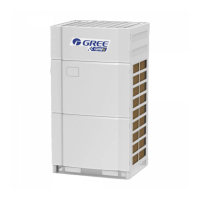GMV DC Inverter VRF
65
Debugging Parameter Reference Value for DC Inverter VRF Unit
12
System
parameter
Outdoor
unit's
parameter
Drive bus voltage of
inverter compressor
V
●
The normal bus voltage is 1.414 times of the
power supply voltage. For example, if the
three-phase power supply voltage is 390V, then
the rectified bus voltage is: 390V
×
1.414 =
551V. The normal deviation between the
measured value and the calculated value within
——
13
Fan operation
frequency
Hz
●
Adjust the operation in the range of 0~90Hz
according to the system pressure adjustment.
——
14
Indoor
unit's
parameter
Inlet tube temperature
of indoor heat
℃
●
According to the ambient temperature, the
inlet temperature is 1
℃
~7
℃
lower than the
outlet temperature for the same indoor unit
under cooling mode.
●
The inlet temperature is 1
℃
~7
℃
the outlet temperature for the same indoor unit
——
15
of indoor heat
exchanger
℃
——
16
Opening of indoor
electronic expansion
valve
PLS
●
2000PLS electronic expansion valve: the
opening is adjusted automatically in the range of
200~2000PLS;
●
480PLS electronic expansion valve: the
opening is adjusted automatically in the range of
70~480PLS.
——
17
Drainage
system
—— —
●
The indoor unit drains smoothly and
thoroughly, and the condensate water pipe has
no slope water storage; the outdoor unit can
drain water from the drain pipe without dripping
directly from the unit foundation.
——
18
Other —— —
●
There is no abnormal noise for the operation
of the compressor, indoor fan and outdoor fan.
The unit is running normally.
——
5 Operation Instruction
For instructions on how to use the air conditioner, please refer to the user manual of wired
controller or remote controller.
6 Maintenance
Regular inspection and maintenance can extend the service life of the air conditioning unit.
6.1 Heat Exchanger of Outdoor Unit
The heat exchanger of outdoor unit should be cleaned regularly. A vacuum cleaner can be used
with a nylon brush to clean dust and debris from the surface of the heat exchanger. If there is
compressed air source, the compressed air can be used to blow dust from the surface of the heat
exchanger. Do not wash it with tap water.
6.2 Drain Pipe
The drain pipe should be checked regularly to allow the condensate to drain smoothly.

